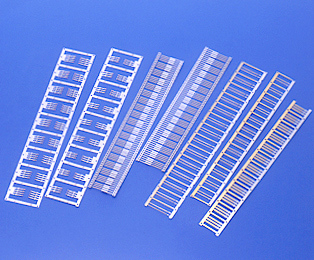What Materials Are Used in IC Packaging?
Jan 17, 2025
Integrated circuit (IC) packaging is a critical process in the semiconductor industry, providing the physical and electrical connection between the silicon chip and the external environment. The choice of materials in IC packaging greatly influences the performance, reliability, and durability of electronic devices.
Overview of IC Packaging
IC packaging serves multiple purposes:
Protection: It shields the silicon chip from environmental factors such as moisture, dust, and mechanical stress.
Electrical Connection: It establishes the necessary electrical pathways between the chip and the external circuitry.
Heat Dissipation: It facilitates the dissipation of heat generated during operation, ensuring the device remains functional.
The materials used in IC packaging must meet stringent requirements, including thermal conductivity, mechanical strength, and compatibility with the silicon chip and the substrate.
Materials in IC Packaging
Several materials are employed in IC packaging, each tailored to specific applications and requirements. These materials include:
Epoxy Molding Compounds (EMCs): EMCs are widely used in transfer molding processes to encapsulate IC chips. They offer excellent mechanical and thermal properties, as well as resistance to moisture and chemicals.
Tungsten Carbide in IC Packaging Mold Parts: Tungsten carbide is a key material used in the fabrication of punches and dies for IC packaging molds. Known for its exceptional hardness and wear resistance, tungsten carbide ensures precise machining and prolonged tool life. This is particularly crucial in the transfer molding process, where the punches and dies must withstand high pressures and temperatures.
Ceramics: Advanced ceramics such as aluminum oxide and aluminum nitride are used for their excellent thermal conductivity and electrical insulation properties. They are commonly employed as substrates in IC packages.
Metals:
Copper: Valued for its high thermal and electrical conductivity, copper is often used for lead frames and heat sinks.
Alloys: Alloys such as kovar and Alloy 42 are used for their compatibility with silicon and their ability to maintain a hermetic seal.
Polymers: Polymers such as polyimides are used as dielectrics and for creating flexible circuits. They offer excellent thermal stability and chemical resistance.
The Role of Tungsten Carbide Mold Parts
In the transfer molding process, punches and dies made of tungsten carbide play a pivotal role. This process involves pressing an epoxy molding compound into the mold cavity to encapsulate the IC chip and its connections. The performance of tungsten carbide mold parts directly impacts the quality of the final IC package.
Durability: Tungsten carbide's high wear resistance ensures the mold parts maintain their dimensions over extended production runs.
Precision: The accurate machining of punches and dies ensures proper alignment and uniform encapsulation.
Heat Resistance: Tungsten carbide withstands the high temperatures generated during the molding process, ensuring consistent performance.
Advances in IC Packaging Materials
The semiconductor industry continuously evolves, driving advancements in IC packaging materials and processes. Recent developments include:
High-Performance EMCs: New formulations offer improved thermal stability and lower moisture absorption, enhancing the reliability of IC packages.
Nano-Structured Tungsten Carbide: Innovations in tungsten carbide manufacturing, such as nano-grain structures, provide even greater wear resistance and toughness for mold parts.
3D Packaging Materials: Emerging materials support advanced packaging techniques like 3D stacking, enabling higher performance and smaller form factors.
Challenges and Solutions
IC packaging faces several challenges, including:
Miniaturization: As devices become smaller, packaging materials must support finer geometries and tighter tolerances.
Thermal Management: The increasing power density of modern chips necessitates materials with superior thermal conductivity.
Environmental Concerns: The industry is moving toward environmentally friendly materials and processes to reduce its ecological footprint.
The materials used in IC packaging are integral to the functionality and reliability of modern electronics. Tungsten carbide mold parts, especially punches and dies, play a crucial role in ensuring precise and durable IC packages. By understanding the properties and applications of these materials, engineers can design and manufacture advanced electronic devices that meet the demands of today’s technology-driven world.If you have purchasing needs for this product, please send your needs to sales0l@dghongyumold.com and we will contact you within 24 hours.
